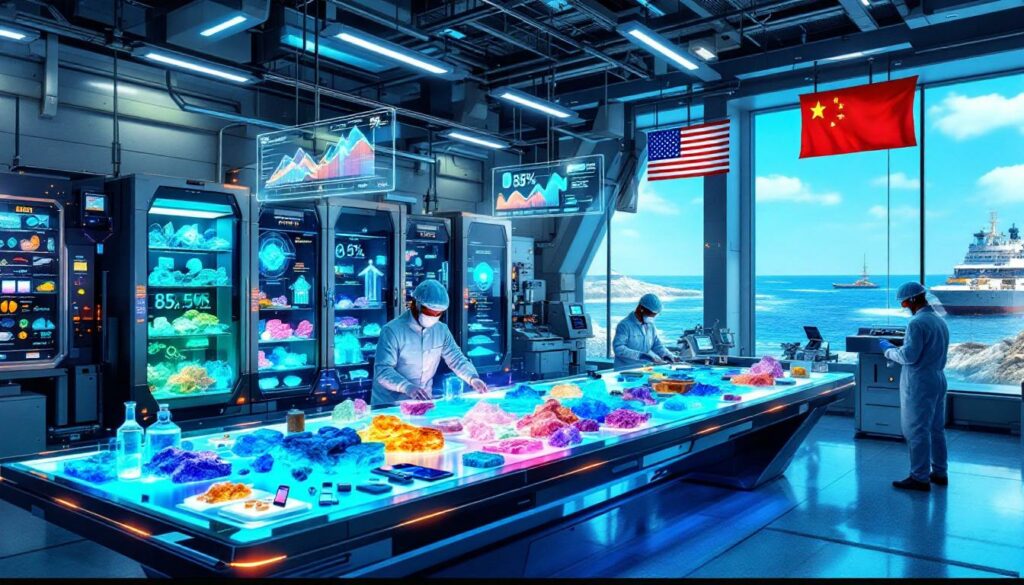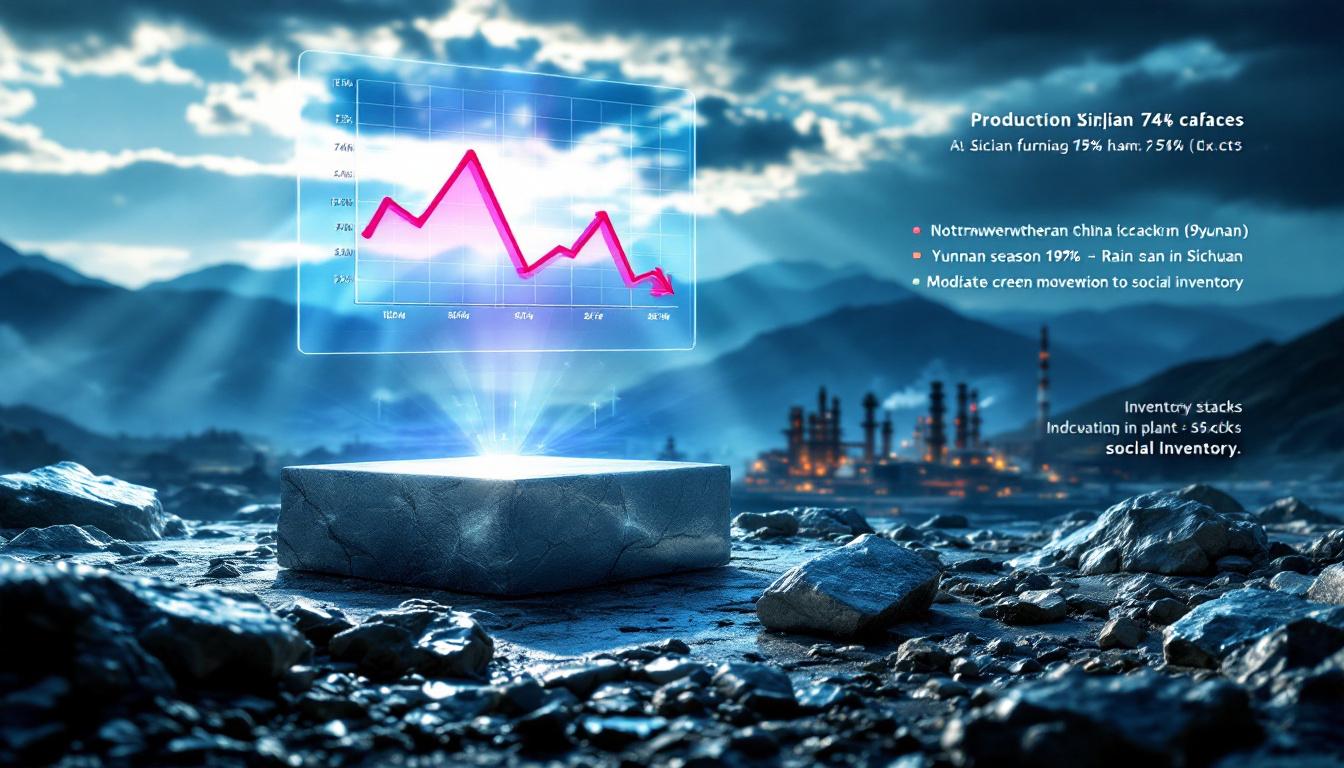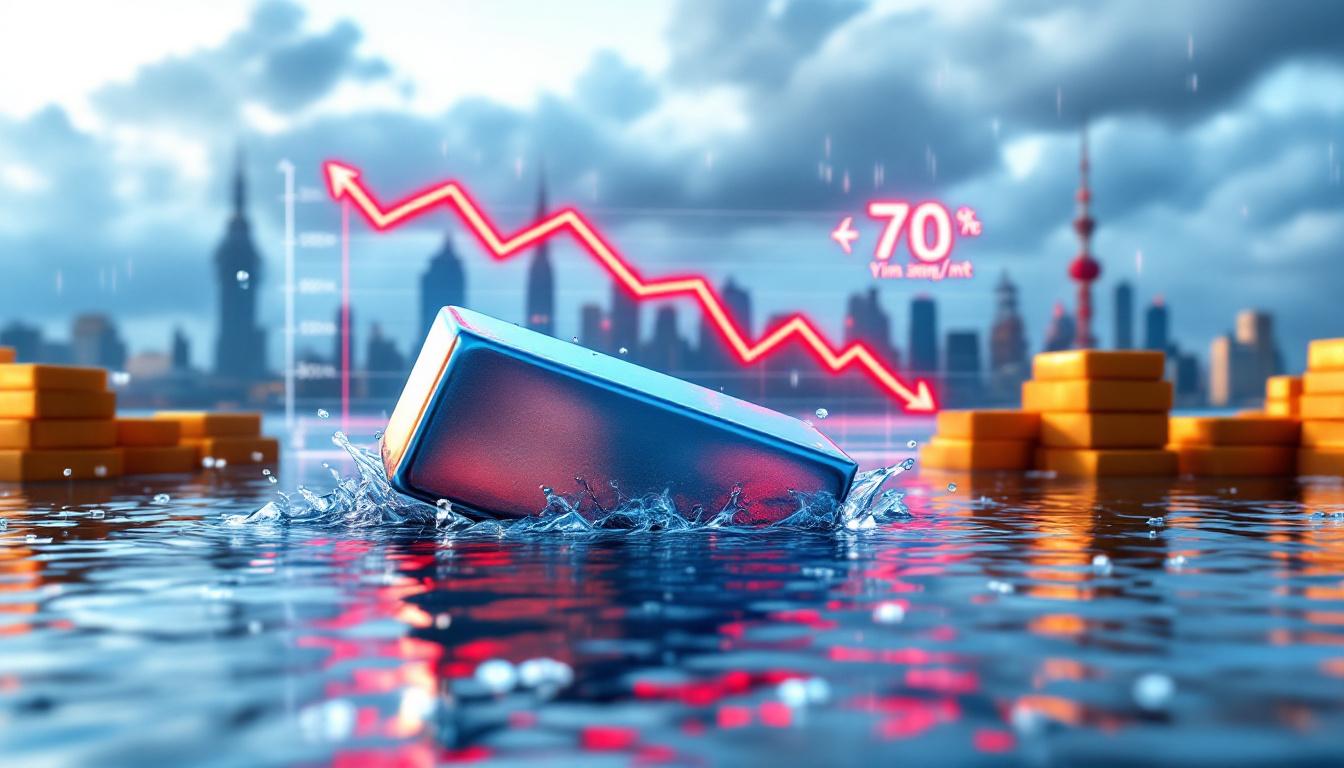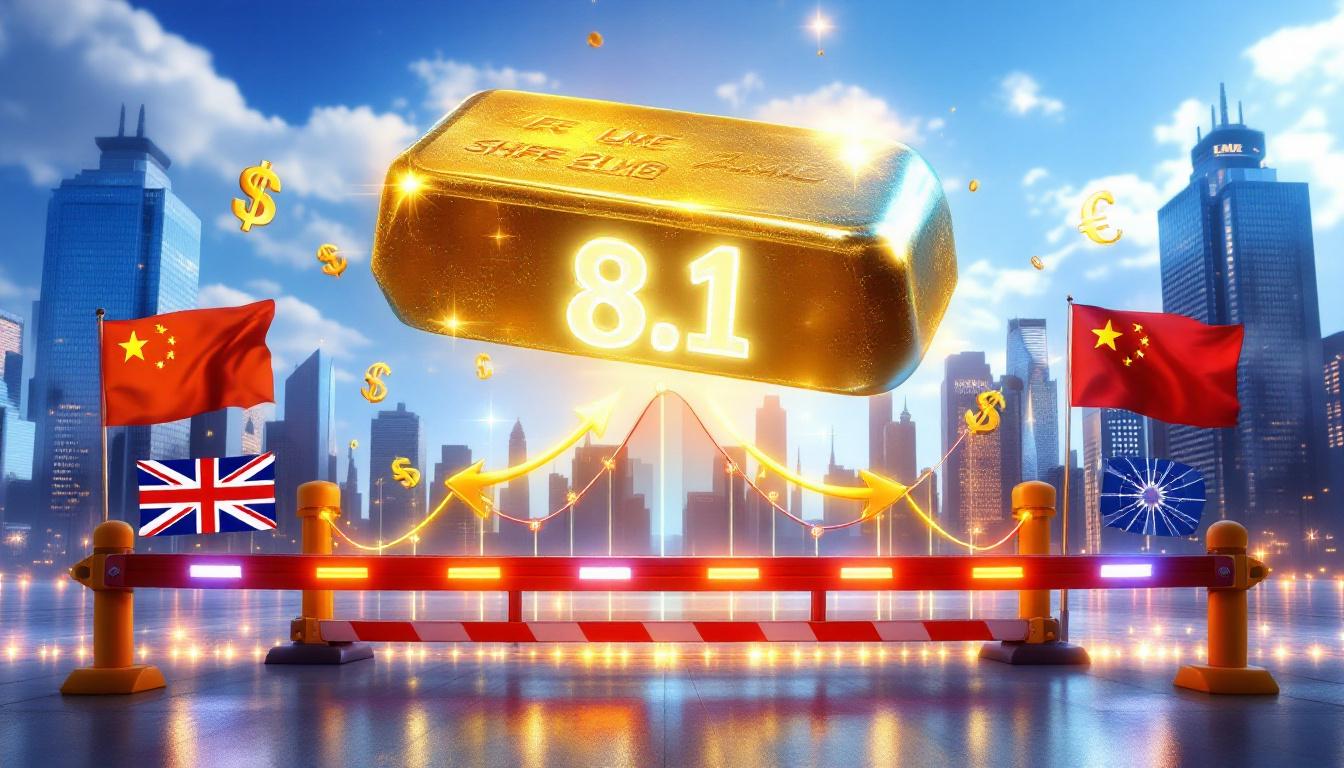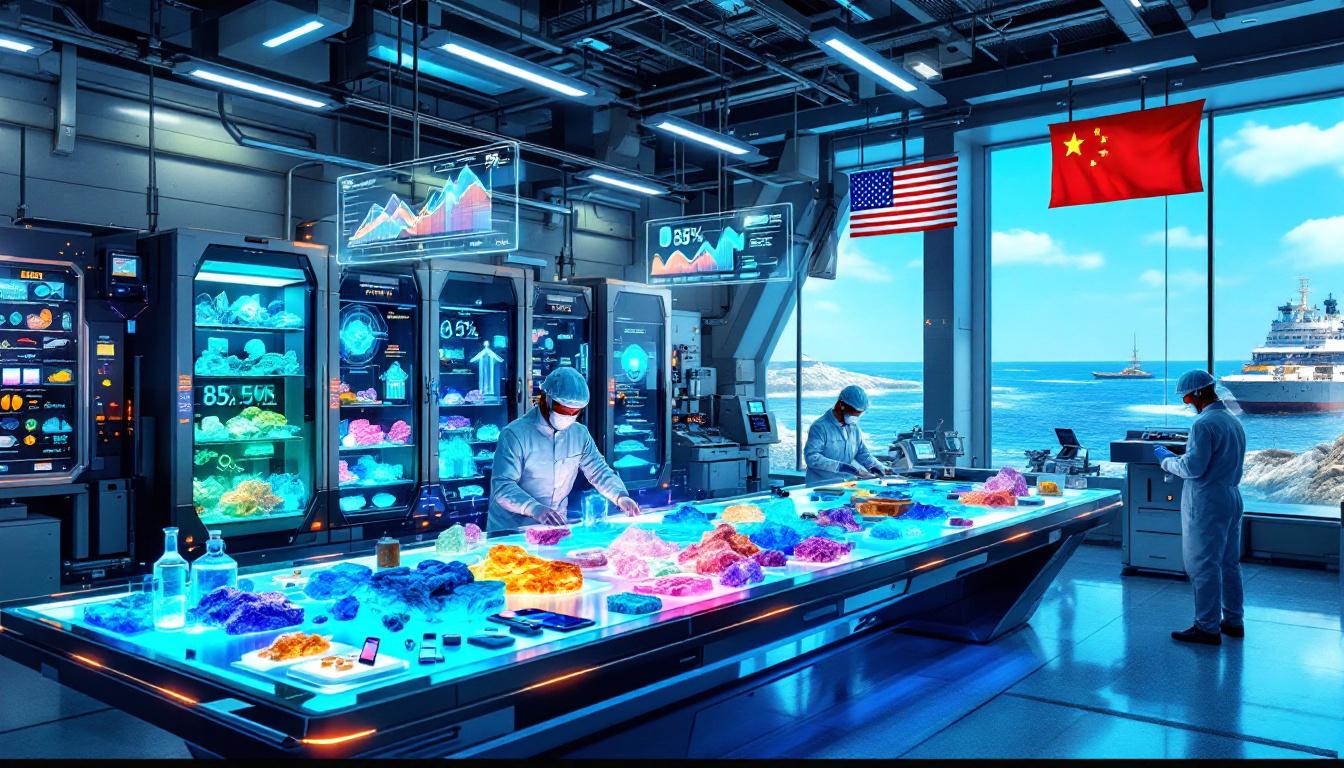What Are Rare Earth Elements and Why Do They Matter?
Rare earth elements (REEs) comprise a group of 17 metals with unique magnetic, luminescent, and electrochemical properties that make them irreplaceable in modern technology. Despite their name, most are relatively abundant in Earth's crust—it's their dispersed distribution and complex extraction processes that create their perceived rarity and strategic importance.
The Strategic Importance of Rare Earth Elements
Rare earth elements have transformed from obscure entries on the periodic table to critical components underpinning national security and technological advancement. These 17 metals (including neodymium, dysprosium, and terbium) are essential components in defense systems, renewable energy infrastructure, and consumer electronics that define modern life.
In defense applications, REEs enable precision-guided munitions, radar systems, and communications equipment. The F-35 fighter jet alone requires approximately 417kg of rare earth materials per unit, according to the Department of Defense's 2025 Strategic Review. This dependency creates vulnerability when supply chains are concentrated in potentially adversarial nations.
For renewable energy technologies, REEs are equally crucial. A single electric vehicle motor typically contains about 1kg of neodymium, according to Adamas Intelligence (2024), while wind turbines require approximately 2 tonnes of rare earths per 3MW of capacity. The addition of dysprosium extends magnet heat resistance to 200°C, enabling high-performance applications in harsh environments.
Looking ahead, demand projections are staggering. The International Energy Agency's Net Zero Roadmap 2023 Revision forecasts a 40% increase in rare earth demand by 2030, driven primarily by the accelerating transition to green technologies. This growth trajectory places immense pressure on existing supply chains and highlights the need for a rare earth breakthrough to meet future needs.
Current Global Distribution of Rare Earth Resources
While rare earth deposits exist worldwide, the processing capacity to transform raw ore into usable materials is heavily concentrated. China controls approximately 85% of global rare earth processing capacity, according to the U.S. Geological Survey's 2024 Mineral Commodity Summaries. This dominance represents the real bottleneck in the West's rare earth supplies.
Western nations face a paradoxical situation: they possess significant rare earth deposits but limited capacity to process them into usable forms. The United States, Australia, Canada, and emerging African sources all contain valuable deposits, yet most still rely on Chinese processing facilities.
Mountain Pass in California stands as America's flagship rare earth mine, yet until recently, it shipped concentrated ore to China for separation and processing—a telling illustration of the bottleneck problem. Australia's significant mining operations similarly face processing limitations, creating a minerals version of the "resource curse" where raw material wealth doesn't translate to industrial advantage.
This distribution imbalance creates significant geopolitical leverage and supply chain vulnerability that Western nations are only beginning to address through critical minerals energy security initiatives.
What Is the Real Bottleneck in Western Rare Earth Supply Chains?
Despite common misconceptions, the primary challenge in establishing secure rare earth supply chains isn't finding the raw materials—it's developing the processing infrastructure required to transform mined ore into usable materials.
Processing Capabilities: The Primary Constraint
"Processing capabilities and large quantities are the real bottleneck," notes Gracelin Baskaran, a rare earths expert at the Center for Strategic and International Studies (CSIS), in a CNBC interview. This bottleneck emerges from the extraordinarily complex chemical processes required to separate and purify rare earth elements.
The separation process is particularly challenging because rare earths share remarkably similar chemical properties. Separating heavy rare earths can require more than 1,000 solvent extraction stages, according to research published in ACS Sustainable Chemistry (2024). This process demands specialized equipment, extensive technical expertise, and significant capital investment.
Establishing commercial-scale processing facilities requires investments exceeding $100 million, according to the U.S. Department of Energy's 2023 Critical Materials Assessment. This high entry barrier limits private sector participation without government support. Furthermore, the facilities must achieve 99.999% purity levels for magnet applications (IEEE Magnetics, 2024), requiring precision engineering and quality control beyond standard mineral processing.
The technical expertise gap presents another significant hurdle. With approximately 70% of separation patents held by Chinese entities (WIPO 2023), Western nations face a knowledge deficit after decades of offshoring. The specialized workforce required to operate these facilities—rare earth separation chemists and engineers—requires 5-7 years of training according to the National Science Foundation's 2025 Report.
Scale Economics and Capacity Limitations
The economics of rare earth processing heavily favor large-scale operations, creating another dimension of the bottleneck. Typical Western processing facilities operate at capacities around 5,000 tonnes per year, while Chinese facilities often process 35,000 tonnes annually (Benchmark Minerals, 2024). This scale differential translates directly to cost advantages.
This minimum efficient scale requirement creates a chicken-and-egg problem for Western producers: they need large-scale facilities to be cost-competitive, but building such capacity requires guaranteed demand that doesn't yet exist domestically. Without achieving economical throughput levels, Western processors struggle to justify the massive capital expenditures required.
The commercial viability challenge becomes evident in corporate behavior. Energy Fuels Inc., for instance, mines rare earths in the United States but ships monazite concentrate to Estonia for separation (according to their Q2 2025 SEC filing)—a roundabout supply chain that reflects the processing bottleneck.
Even established Western mining companies face this constraint. MP Materials, America's primary rare earth producer, can mine and concentrate materials but lacks full capability to separate heavy rare earths domestically, according to their Q1 2025 Investor Report. This forces a continued reliance on overseas processing despite significant mining capacity and underscores the need for mining industry innovation to address these challenges.
How Has China Established Dominance in Rare Earth Processing?
China's commanding position in rare earth processing didn't develop by accident. It represents the culmination of decades of strategic planning, investment, and policy support that transformed the country from a raw materials exporter to the dominant force in the entire rare earth value chain.
Historical Development of China's Processing Advantage
China's rare earth strategy began in earnest during the 1980s, when the government identified these materials as strategically important for future technological development. Between 1980-2000, China invested approximately $20 billion in rare earth research and development according to China State Council Archives, establishing a foundation for technological leadership.
Under the guidance of Xu Guangxian, often called the "Father of Chinese Rare Earths," the country developed increasingly sophisticated separation techniques. This research focus yielded significant dividends, as China now holds the majority of global patents related to rare earth processing technology.
The Chinese government supported this development through preferential policies, including export quotas that incentivized foreign manufacturers to relocate production to China to secure material access. This created a virtuous cycle for China: more manufacturing presence created more demand for processed rare earths, which justified further expansion of processing capacity.
By the 1990s, China's combination of low costs, growing technical expertise, and integrated supply chains allowed it to systematically outcompete Western producers. The closure of the Mountain Pass mine in California in 2002 symbolized this shift, as American production could not remain viable against Chinese competition.
The vertical integration from mining through manufacturing that Baskaran highlighted in her CNBC interview became China's distinctive advantage. The Baotou Rare Earth Complex in Inner Mongolia exemplifies this approach, processing approximately 120,000 tonnes annually while supporting downstream manufacturing, according to their 2024 Corporate Sustainability Report.
Environmental and Cost Considerations
Environmental regulation differences have played a significant role in China's competitive advantage. Rare earth processing generates substantial toxic waste and often contains radioactive elements like thorium that require careful management. The less stringent environmental controls historically applied in China created significant cost advantages.
Wastewater treatment costs illustrate this disparity: processing wastewater costs approximately $0.20 per tonne in China versus $8 per tonne in the United States, according to World Bank data (2024). This environmental compliance gap adds between 15-30% to production costs in Western facilities, based on IMF Working Paper assessments from 2023.
Chinese ionic clay deposits in southern provinces offer another advantage, as they can be processed with methods that produce less radioactive waste compared to hard rock mining, according to research published in Nature Sustainability (2024). This geological advantage complements the regulatory differences.
Water usage concerns also impact Western operations. Rare earth processing requires significant water resources for separation and waste management. In water-stressed regions like the American Southwest, this creates additional sustainability challenges and potential community opposition that Chinese operators have historically faced to a lesser degree.
"The environmental regulatory differences aren't just about pollution control—they represent fundamentally different approaches to balancing industrial development with environmental protection. Western producers must internalize environmental costs that their Chinese counterparts have historically externalized." — Environmental assessment from the IMF Working Paper, 2023
What Strategies Are Western Nations Pursuing to Address the Bottleneck?
Faced with supply chain vulnerabilities and growing demand, Western nations are implementing multi-faceted strategies to overcome the rare earth processing bottleneck. These approaches combine government intervention, private investment, and international cooperation to rebuild domestic capabilities.
Japan's Deep Sea Mining Initiative
Japan, with few terrestrial mineral resources but substantial high-tech manufacturing, has pioneered an innovative approach to rare earth security through deep-sea mining. The Japanese Oil, Gas and Metals National Corporation (JOGMEC) has allocated $200 million to deep-sea mining technology development in their 2025 budget.
Japanese research vessels have identified significant rare earth-rich mud deposits within the country's exclusive economic zone near Minamitorishima Island. These seafloor deposits contain concentrations of rare earths several times higher than typical terrestrial mines, potentially offering Japan a domestic supply source.
What makes Japan's approach distinctive is its simultaneous development of extraction technologies and processing capabilities. As Baskaran noted in her CNBC interview, "Japan's push for deep-sea mining manufacturing is crucial" because it addresses both ends of the supply chain simultaneously.
The technical challenges are formidable. Polymetallic nodule extraction occurs at depths reaching 4,000 meters, according to MIT's Deep Sea Mining Tech Review (2024). At these extreme depths, specialized equipment must withstand enormous pressure while minimizing environmental impact—a significant engineering challenge that Japanese researchers are systematically addressing despite ongoing deep sea mining controversy regarding ecological impacts.
Japan's strategy represents a potential game-changer for rare earth geopolitics, as successful commercialization would create a new supply source outside Chinese influence. For Japan's high-tech manufacturing sector, particularly in robotics, electric vehicles, and electronics, securing this supply would provide significant competitive advantages.
Government-Industry Partnerships in Western Nations
Western governments have recognized that market forces alone cannot overcome China's entrenched advantages in rare earth processing. This realization has prompted unprecedented government intervention through funding, policy support, and strategic frameworks.
The United States has leveraged the Defense Production Act, allocating $1.2 billion specifically for rare earth development in the Department of Defense's FY2025 Budget. This funding supports domestic mining, processing, and manufacturing to create resilient supply chains for defense applications.
Simultaneously, the European Union has implemented the Critical Raw Materials Act, which establishes concrete targets for domestic processing capacity. The Act's Annex outlines investments exceeding $1 billion needed for developing a full European rare earth supply chain, acknowledging the scale of financial commitment required.
Australia, blessed with significant rare earth deposits, has actively pursued bilateral partnerships to develop processing capabilities. The Australia critical minerals reserve initiative, along with the Australia-Germany supply chain Memorandum of Understanding signed in April 2025, exemplifies this approach, linking Australian mining capabilities with German manufacturing and processing expertise.
Public-private investment models have emerged as the preferred structure for these initiatives. Government funding reduces initial risk, while private sector participation ensures commercial viability. The Department of Energy's $20 million prize for rare earth recycling technology announced in April 2025 illustrates this approach, stimulating private innovation through public incentives.
Reshoring and Friend-Shoring Approaches
Western nations are pursuing dual strategies of reshoring critical capabilities while simultaneously diversifying supply chains across allied nations—an approach often called "friend-shoring."
Reshoring efforts focus on rebuilding domestic processing capabilities that atrophied during the decades of Chinese dominance. The challenge is substantial: establishing separation facilities, training specialized workforces, and creating the industrial ecosystem needed for a functioning supply chain. The five-to-ten-year development cycles for new facilities reflect this complexity.
Friend-shoring complements these domestic efforts by creating resilient supply networks across allied nations. The Minerals Security Partnership, which now includes 14 member nations according to the State Department (2025), coordinates investments and policy approaches across like-minded countries.
These strategic alliances distribute risk and leverage comparative advantages. Australia contributes mining expertise, Japan offers advanced manufacturing capabilities, and European partners provide process engineering knowledge. This networked approach presents a potential counterweight to China's integrated supply chain.
Trade agreements increasingly focus on critical mineral security, with specific provisions addressing rare earth elements. These frameworks establish preferential access to materials and technologies among partner nations while maintaining environmental and labor standards that align with Western values.
What Challenges Face Deep Sea Mining for Rare Earths?
While deep sea mining represents a promising frontier for rare earth extraction, particularly for maritime nations like Japan, it faces significant challenges that must be addressed before commercial-scale operations become viable.
Maritime Security Considerations
The security dimensions of deep sea mining operations add complexity to an already challenging endeavor. Extraction infrastructure operating in international or disputed waters faces potential vulnerabilities that terrestrial mining operations don't encounter.
Territorial disputes in resource-rich areas present particular concerns. Tonga's exclusive economic zone dispute with China (International Tribunal for the Law of the Sea Case No. 28) illustrates how competing claims can complicate access to seabed resources. As nations increasingly recognize the strategic value of these deposits, such disputes may intensify.
The protection of extraction infrastructure presents another security challenge. Underwater operations are inherently difficult to monitor and defend, making them potentially vulnerable to sabotage, espionage, or disruption during periods of international tension. Securing thousands of kilometers of seafloor operations requires new security paradigms not yet fully developed.
International legal frameworks governing deep sea mining remain in flux. The International Seabed Authority (ISA) has delayed finalization of comprehensive regulations until 2027, according to a UN Press Release from March 2025. This regulatory uncertainty complicates investment decisions and operational planning for companies and countries pursuing this approach.
Environmental Impact Concerns
Environmental considerations represent perhaps the most significant barrier to widespread adoption of deep sea mining. Approximately 75% of marine biologists oppose commercial deep sea mining operations, according to the Deep Sea Conservation Coalition (2024), reflecting scientific concerns about potential ecosystem disruption.
The direct impact on the ocean floor is substantial. Nodule collection disturbs approximately 10cm of seabed sediment, according to research published in Science Advances (2024). This disturbance affects benthic organisms and habitats that have evolved in stable conditions for millions of years.
Our limited understanding of deep-sea environments compounds these concerns. Marine scientists estimate that less than 20% of deep ocean ecosystems have been comprehensively studied, making it difficult to establish environmental baselines or predict recovery patterns following extraction activities.
Sediment plumes generated during collection operations represent another environmental concern, as they can travel significant distances from extraction sites, potentially affecting marine life across wider areas. The suspended particles can impact filter-feeding organisms and light penetration, with cascading effects through marine food webs.
These environmental concerns necessitate comprehensive impact assessments before commercial operations can proceed. However, the relative novelty of the technology and operating environment makes such assessments inherently challenging. The precautionary principle suggests moving carefully in the face of such uncertainty.
Technical and Economic Viability
The extreme operating environment of deep sea mining creates unprecedented technical challenges. Equipment must function reliably at depths where pressure exceeds 400 atmospheres, temperatures approach freezing, and communications with surface vessels face significant limitations.
The economics of deep sea rare earth extraction remain uncertain. While Japanese research has identified promising deposits, the full costs of commercial extraction, transportation to surface vessels, and initial processing at sea haven't been definitively established. The capital-intensive nature of these operations requires substantial investment before economic viability can be demonstrated.
The technology readiness levels for key components of deep sea mining systems continue to advance but remain below those of conventional mining. Prototype systems have demonstrated basic functionality, but the leap to commercial-scale operations represents a significant engineering challenge that will require continued investment and innovation.
Cost competitiveness against traditional mining ultimately determines whether deep sea extraction becomes a meaningful part of rare earth supply chains. If terrestrial rare earth prices rise due to environmental compliance costs or geopolitical factors, the economic case for seabed mining strengthens. Conversely, breakthroughs in conventional processing or recycling could undermine the economic rationale for pursuing these technically challenging underwater deposits.
How Can Western Nations Build Competitive Processing Capabilities?
Rebuilding competitive rare earth processing capabilities in Western nations requires coordinated action across investment, technology development, workforce training, and policy frameworks. The scale of this challenge is matched only by its strategic importance.
Investment Requirements and Timeframes
Establishing competitive processing capabilities demands substantial and sustained financial commitments. Comprehensive supply chain development requires between $500 million to $1 billion according to
Ready to Capitalise on the Next Major Mineral Discovery?
Discovery Alert's proprietary Discovery IQ model provides real-time notifications on significant ASX mineral discoveries, instantly transforming complex data into actionable insights for investors. Explore historic examples of exceptional market returns on Discovery Alert's dedicated discoveries page and position yourself ahead of the market with a 30-day free trial.
